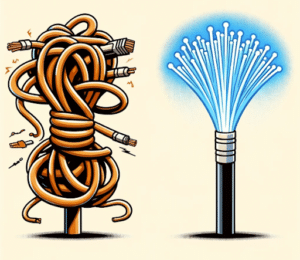Fiber optic technology has revolutionized the way we connect and communicate, offering unparalleled benefits that are essential in today’s digital world. The reliability of fiber optics connections stands out, providing stable and consistent connectivity that businesses and individuals can count on. As the demand for seamless integration of new technologies grows, the ability to integrate fiber optics without service disruption becomes a critical aspect. This seamless integration ensures that users experience no downtime or loss of quality, making the transition smooth and efficient. This will provide you the step-by-step guidelines for successful integration.
Understanding Fiber Optic Technology
Fiber optic technology uses light to send information through thin glass or plastic fibers, making it faster and more efficient than traditional copper cables. Fiber optics offer higher bandwidth and speed, handling large data volumes effectively. They are also more reliable over long distances, with less risk of interference.

Pre-Integration Planning
Importance of thorough planning before integration.
Pre-integration planning is a crucial step in the successful integration of fiber optic technology, emphasizing the need for meticulous preparation and strategy.
Consulting with fiber optic experts and service providers.
Consulting with fiber optics experts and service providers like PC and Cable plays a pivotal role in this phase, as our specialized knowledge and experience are invaluable in foreseeing obstacles and recommending the best practices for integration.
We can provide insights into the:
- Technical requirements,
- Infrastructure adjustments
- Compatibility considerations
Step-by-Step Guide to Integrating Fiber Optic
Assessment and Network Analysis
This step is crucial for understanding the scope of the upgrade and planning accordingly. The current infrastructure is evaluated to determine:
- Compatibility with fiber optic systems and
- Identify specific requirements for integration.
Choosing the Right Fiber Optic Solutions
Choosing the Right Fiber Optics Solutions involves:
- Selecting the appropriate types of fiber optic cables and
- Equipment
tailored to meet the operational needs and budget constraints of the entity.
Installation Process
In the Installation Process, the expertise of our professional Installers comes into play, ensuring the fiber optics infrastructure is correctly set up with minimal downtime to prevent service disruption.
Testing and Quality Assurance
Testing and Quality Assurance are paramount to confirm the efficiency and reliability of the fiber optic network. This includes:
- Conducting extensive testing
- Troubleshooting to ensure optimal performance.
Maintaining Your Fiber Optic Network
Maintaining your fiber optic network is essential for ensuring its longevity and optimal performance. Regular maintenance involves:
- Routine checks and
- Cleaning of the fiber optics components
Monitoring performance and making adjustments
Monitoring network performance is also crucial, as it allows for timely adjustments to be made to maintain the efficiency and reliability of the network.
Regular analysis and diagnostics can help identify trends or irregularities that may indicate underlying problems.
Takeaways
The integration of fiber optics technology is a transformative step for any network, offering significant benefits in terms of speed, bandwidth, and reliability. The journey to upgrading with fiber optics underscores the importance of careful planning and the utilization of professional resources. Such meticulous preparation and expert involvement ensure a smooth transition and the successful implementation of a more robust and efficient network infrastructure. We emphasize the strategic approach necessary to fully leverage the advantages of fiber optics. This not only increases network performance but also future-proofs the infrastructure against the rapidly evolving demands of modern technology. Hence, organizations and individuals are encouraged to embrace fiber optic solutions, engaging with knowledgeable professionals from PC and Cable to guide them through the process and maximize the potential of their network systems.
Frequently Asked Questions
1. What Is Fiber Optics Integration?
Fiber optics integration involves the process of upgrading network systems to incorporate fiber optic cables, enhancing both speed and bandwidth significantly.
2. Why Choose Fiber Optics Over Copper?
Fiber optics offer superior data transmission speeds and greater reliability over longer distances compared to traditional copper cables, making them a preferable choice.
3. What Are the Benefits of Integrating Fiber Optic Cables for Organizations?
Organizations can experience faster internet speeds, augmented data capacity, and significantly more dependable network performance through the integration of fiber optic cables.
4. What Should Be Considered Before Integrating Fiber Optics?
Before integrating fiber optics, it’s important to assess the current network infrastructure, ensure compatibility with fiber optics technology, consider budget constraints, and determine the specific type of fiber optic equipment required.
5. Can Existing Networks Be Upgraded to Fiber Optics?
Yes, many existing network systems can be seamlessly upgraded to fiber optics, often without necessitating a complete system overhaul.
6. How Long Does Fiber Optic Integration Take?
The duration of fiber optics integration can vary widely, ranging from just a few days to several months, depending primarily on the scale of the project
7. Will There Be Any Service Disruptions During Integration?
While there might be minimal service disruptions during the integration process, effective planning can substantially minimize any potential downtime.
8. Is Professional Assistance Required for Fiber Optics Integration?
For more complex networks or to ensure a high quality of installation, enlisting the help of professionals specialized in PC and cable services is often advisable

